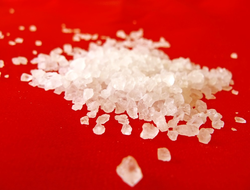Sodium: An essential macromineral
Published: March 11, 2022
Reducing salt consumption, or to be more precise sodium consumption, is a high priority with several international health authorities.
A high sodium intake is linked to hypertension (high blood pressure) which in turn is associated with an increased risk of heart disease and stroke.
Too much or too little of most nutrients can be detrimental to health and sodium is no exception.
Too little sodium in the diet may also increase the risk of heart disease.
Health studies have also reported a link between high sodium intake and incidence of stomach cancer.
What can you do to ensure you consume enough, but not too much, sodium?
Understanding how much sodium you need, which foods contain more or less sodium, and why you need sodium can help you determine whether or not you are consuming a healthy amount of sodium.
What is sodum?
The terms sodium and salt are often used interchangeably.
However, sodium is a single mineral whereas table salt is an ionic compound composed of two minerals: sodium and chloride = sodium chloride (NaCl).
Refined table salt is used as a condiment and in food processing and preservation. Iodine is usually added to table salt to prevent iodine deficiencies which affect thyroid metabolism.
Sea salt, also sodium chloride, is unrefined and contains other minerals such as calcium and magnesium, as well as other components depending on the geographical location where the sea salt has been sourced.
Sea salt forms as briny (salt) water evaporates and will dissolve in water or other fluids as will table salt.
Although high dietary sodium intake can be detrimental to health, sodium is considered an essential major mineral as it is present in the body, and necessary for optimal health in relatively large amounts measured in milligrams (mg).
Chloride is also an essential mineral.
As with all minerals found in your body, sodium may combine with other elements to form salts, but the chemical identity of the mineral is not changed.
Sodium remains in your body until excreted.
Adequate Intake (AI)
Adequate intake is the average daily amount of a nutrient that appears sufficient for most healthy people.
This value is used when an RDA (Recommended Dietary Allowance) cannot be determined...
References
1.
Gropper, S.S., Smith, J.L. & Groff, J.L. (2005). Advanced Nutrition and Human Metabolism (4thEd.). Belmont, CA: Thomson Wadsworth.
2.
Whitney, E. & Rady Rolfes, S. (2005). Understanding Nutrition. Belmont, CA: Thomson Wadsworth
3.
Nutrition Action Health letterCSPI Jan 2010, Oct 2010, Aug 2011, Jan 2012, Sep 2012, July 2013, April 2014, Oct 2014
4.
Food for life report, Health Science and Law Jan 2017

